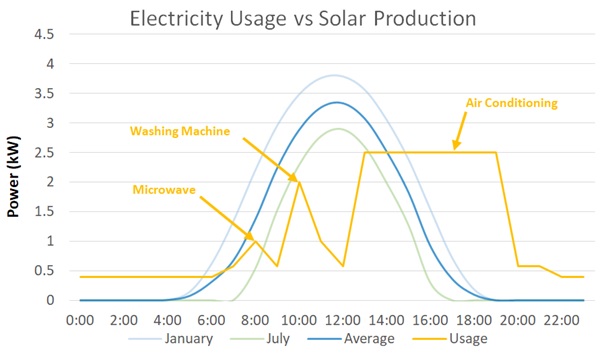What is it and how do I do it?
You might have heard of some thrifty folk who like to use power at weird times of night to save on electricity. These are households who are on Time of Use electricity plans and get charged different rates at different times of the day. If they use power at the cheapest time of day, which is known as “Off Peak” and occurs between 10PM-7AM, they will be buying electricity at a cheaper rate. Shifting your electricity usage periods to save money is the basic premise of Load Shifting, but once you have solar, it gets even better.
When you get a solar system you’ll be producing your own solar power during the day for free. This means when you run your dishwasher while the sun is out, you aren’t paying for electricity. Where some homeowners might use power during Off Peak times so they only use the cheapest electricity rates, you can now use electricity for free by using it when your solar system is running. By shifting as much of your electricity usage as possible to during the day, you’ll effectively be running those appliances for free since you aren’t buying any power from the grid.
But be careful! If you run too many appliances at once you may start to draw electricity from the grid. A suitably sized solar system should have enough power to run your appliances without needing help from the grid. But some appliances have a large start-up current, and when combined with other usages, you may be drawing in excess of what your solar inverter is rated at. For example, if you have a 3kW rated air conditioner, a 1000W microwave and a washing machine that draws 2kW during start-up, you’re pulling a huge 6kW of power. If you have a 5kW rated solar system, you might have to turn off your air-conditioner until you’ve finished your chores.
Effective load shifting is all about learning about your power consumption, knowing the performance of your solar system, and managing your appliances. See our previous blog on Appliance Power Usage to get an idea of how much power each appliance will draw. If you can combine these skills with effective energy saving techniques, like:
- keeping a tight thermal envelope,
- turning off unneeded appliances, and
- not running heating and cooling excessively,
you can greatly reduce your household electricity bills and your reliance on grid power.
Another hot tip is to stagger your big electricity consumers throughout the day if you can. See the example below for a 5kW solar system:

The example above shows energy usage throughout the day, compared to the bell curve of solar production for a 5kW solar system as the sun rises and sets. All the power consumed within the bell curve will be drawn from your solar, and anything outside of that will be drawn from the grid.
There is 400W (0.4kW) of constant, standby power being used, until the morning when someone uses the microwave at 8AM. On average this power usage will be offset by solar (except in Winter, seen in green). At 10AM the washing machine starts up at 2kW and then ramps down to 1kW on its 2 hour cycle. This is also offset by solar. Finally, the air conditioning is turned on at 1PM and draws a constant 2.5kW until it is turned off at 7PM. The air conditioning is only offset by the solar system for an hour, and then as the sun goes down we end up drawing the full 2.5kW from the grid at 6PM. A more economical solar user could have turned the air conditioning on earlier in the day and switched it off before the sun set completely.
Any solar power that is produced above what you are consuming will be sold back to the grid at a meagre 12c/kWh. So, the most sensible thing to do is try and utilise as much of that solar power as possible by shifting loads you would normally run when the sun is down, to during the day. This will save you the 25-55c/kWh you pay for electricity. Efficient load management can reduce the payback period of a solar system from 5 years to 3 years and cut your electricity bill by 50%-100%.
